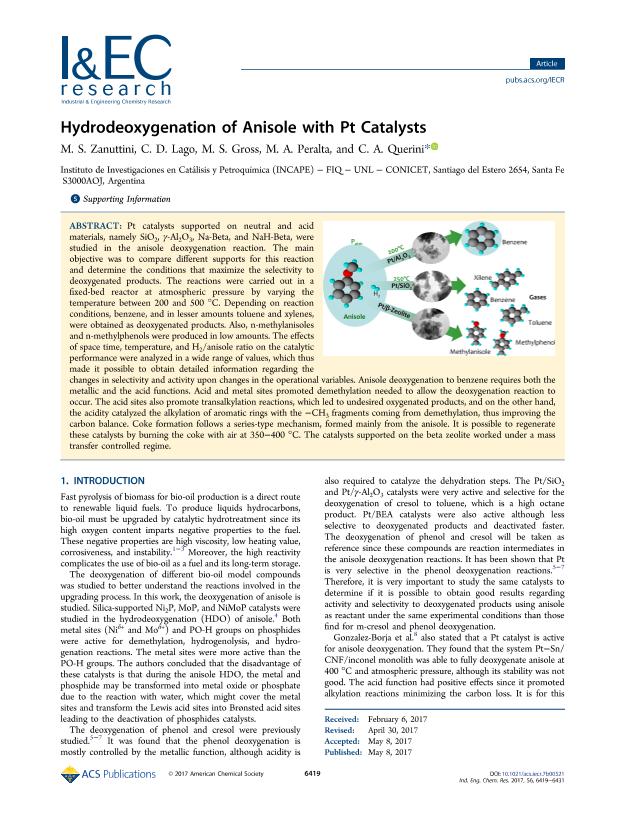Artículo
Hydrodeoxygenation of Anisole with Pt Catalysts
Zanuttini, María Soledad ; Lago, Camila Desire
; Lago, Camila Desire ; Gross, Martin Sebastian
; Gross, Martin Sebastian ; Peralta, María Ariela
; Peralta, María Ariela ; Querini, Carlos Alberto
; Querini, Carlos Alberto
 ; Lago, Camila Desire
; Lago, Camila Desire ; Gross, Martin Sebastian
; Gross, Martin Sebastian ; Peralta, María Ariela
; Peralta, María Ariela ; Querini, Carlos Alberto
; Querini, Carlos Alberto
Fecha de publicación:
06/2017
Editorial:
American Chemical Society
Revista:
Industrial & Engineering Chemical Research
ISSN:
0888-5885
Idioma:
Inglés
Tipo de recurso:
Artículo publicado
Clasificación temática:
Resumen
Pt catalysts supported on neutral and acid materials, namely SiO2, γ-Al2O3, Na-Beta, and NaH-Beta, were studied in the anisole deoxygenation reaction. The main objective was to compare different supports for this reaction and determine the conditions that maximize the selectivity to deoxygenated products. The reactions were carried out in a fixed-bed reactor at atmospheric pressure by varying the temperature between 200 and 500 °C. Depending on reaction conditions, benzene, and in lesser amounts toluene and xylenes, were obtained as deoxygenated products. Also, n-methylanisoles and n-methylphenols were produced in low amounts. The effects of space time, temperature, and H2/anisole ratio on the catalytic performance were analyzed in a wide range of values, which thus made it possible to obtain detailed information regarding the changes in selectivity and activity upon changes in the operational variables. Anisole deoxygenation to benzene requires both the metallic and the acid functions. Acid and metal sites promoted demethylation needed to allow the deoxygenation reaction to occur. The acid sites also promote transalkylation reactions, which led to undesired oxygenated products, and on the other hand, the acidity catalyzed the alkylation of aromatic rings with the -CH3 fragments coming from demethylation, thus improving the carbon balance. Coke formation follows a series-type mechanism, formed mainly from the anisole. It is possible to regenerate these catalysts by burning the coke with air at 350-400 °C. The catalysts supported on the beta zeolite worked under a mass transfer controlled regime.
Palabras clave:
Anisole Oxydehydrogenation
,
Platinum
,
Zeolites
,
Coke
Archivos asociados
Licencia
Identificadores
Colecciones
Articulos(INCAPE)
Articulos de INST.DE INVEST.EN CATALISIS Y PETROQUIMICA "ING. JOSE MIGUEL PARERA"
Articulos de INST.DE INVEST.EN CATALISIS Y PETROQUIMICA "ING. JOSE MIGUEL PARERA"
Citación
Zanuttini, María Soledad; Lago, Camila Desire; Gross, Martin Sebastian; Peralta, María Ariela; Querini, Carlos Alberto; Hydrodeoxygenation of Anisole with Pt Catalysts; American Chemical Society; Industrial & Engineering Chemical Research; 56; 22; 6-2017; 6419-6431
Compartir
Altmétricas



